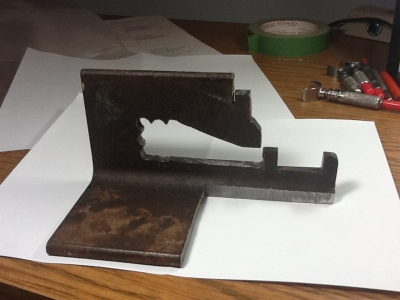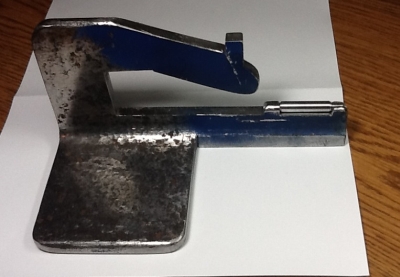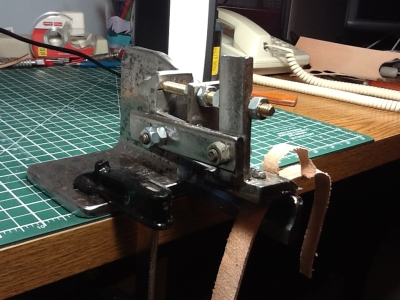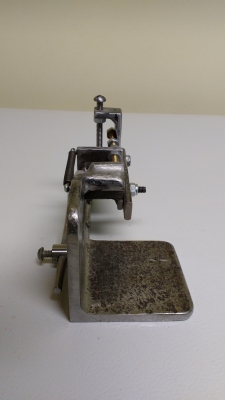-
Posts
6,523 -
Joined
-
Last visited
Content Type
Profiles
Forums
Events
Blogs
Gallery
Everything posted by Northmount
-
The round leather belt will ride just fine in the pulley on the servo motor. Note you can't do a back/lock stitch by turning a sewing machine backwards. The hook is designed to only pick up the thread loop when turning the correct direction. It can not pick up the thread loop when turned backwards. Tom
-
.thumb.jpg.6e903dd66163ad5672f00f144058c571.jpg)
Question on punching holes with a hole punch
Northmount replied to Windrider30's topic in How Do I Do That?
Don't measure from hole to hole, as any small errors will keep increasing and throwing your two rows out of sync. Keep the ruler (use a ruler or tape) in place, mark off each hole without moving the ruler down each time. So if you were making the holes 1/2" apart, you mark at 0, 1/2", 1", 1.5", 2", etc. If you use a scratch awl or pencil/pen, just make small marks in a straight line. When punching, press the punch centered over the mark, just hard enough to leave a slight impression. Check to see if it is centered, correct the location if not, then punch the hole using the mark plus the punch impression as a guide. You could make a punching guide or template out of a strip of wood or plexiglass or similar plastic material if you will be making several articles the same. Will help speed up production. You could also use painters green tape to place your marks, and punch through it, then remove the tape after. Then you won't be marking the leather itself. Tom Edit: Or modify this as Halitech suggests above. We posted at the same time! -
You will see that location has been changed to Home>Marketplace>Items For Sale>Machinery -- Sewing and Stitching>New and Refurbished to Like New (This info is just below the Browse Menu line near the top of this page.) I left a link in the original location that brings you to this section of the forum, so you can find what appears to be it in your original post location and here as well. Tom
- 7 replies
-
- jewels
- accessories
-
(and 7 more)
Tagged with:
-
Moved! Tom
- 7 replies
-
- jewels
- accessories
-
(and 7 more)
Tagged with:
-
Depends on the level of detail you need to be able to do. Just general overal dye job doesn't need fancy setup artists use for drawing/painting fancy art. Have a new Iawata in the drawer I have never used in the past 4 years. Tom
-
.thumb.jpg.6e903dd66163ad5672f00f144058c571.jpg)
How to tan a deer hide for hair-on hide
Northmount replied to metroplexchl's topic in How Do I Do That?
Moved to "how do I do that" unless you are looking for someone to do it for you. Tom -
Nice job. I used to tool a lot of roses. Still like to do them. Tom
- 2 replies
-
- dobro
- resonator guitar
-
(and 1 more)
Tagged with:
-
From other posts on clutches, the cork needs some grease lube to be able to slip smoothly. Tom
-
.thumb.jpg.6e903dd66163ad5672f00f144058c571.jpg)
Keeping A Sewing Shop Going During Grid Outages
Northmount replied to cdthayer's topic in Leatherwork Conversation
Moved. I hadn't noticed it being in the wrong area. Tom -
.thumb.jpg.6e903dd66163ad5672f00f144058c571.jpg)
Idea on tree
Northmount replied to T Moore Medicine Hat Saddlery's topic in General Saddlery Discussion
Take a look at Rod Nikkel's site. They have retired from tree making, but have left the site up as a resource for all to use. You might find some of your answers there. http://www.rodnikkel.com/content/pictures-of-trees/ Tom -
.thumb.jpg.6e903dd66163ad5672f00f144058c571.jpg)
Keeping A Sewing Shop Going During Grid Outages
Northmount replied to cdthayer's topic in Leatherwork Conversation
For USA and Canada, take a look at a Generac standby generator. Runs off natural gas or propane. My son lives out in the sticks and is subject to several outages a year. During June and July, he has to keep up to 3 sump pumps running due to heavy rains and high water table. Local power poles have fallen over due to the wet conditions, leaving them with no power for several hours. Also needs power for water and septic tank systems. He has a fire sprinkler system that is useless if there is no power as he would have no water. He put in a 22 kW unit with automatic transfer switch. http://www.homedepot.com/p/Generac-22-000-Watt-Air-Cooled-Automatic-Standby-Generator-with-200-Amp-SE-Rated-Transfer-Switch-6551/205398231 It is a very reliable unit, quiet, easy to install, just need to rewire the main feed to the main panel. It has been a real lifesaver. Tom -
Also be careful how you pull and twist them through the leather. The eye of course is the weakest point so fairly easy to snap while the eye is buried in the leather. If using pliers, be even more careful to keep the needle straight. Tom
-
Seller's location appears to be Fort Erie, Ontario based on his IP address. I think it is clear he is selling the press. @threepetsThe requirements of this forum are that you detail the condition of the item and that you provide your selling price. Tom
-
See https://www.google.ca/search?q=+ASF%26T&ie=utf-8&oe=utf-8&gws_rd=cr&ei=VhzWV8KFOo6cjwOOz4SgCQ#q=ASF%26T+hole+punch for several ASF&T punches. Looks like Osbourne related. Used for leather and gaskets. Tom
-
See this link for a new rein rounder at Weaver Leather http://www.weaverleathersupply.com/Mobile/Catalog/ItemContent.aspx?ItemNumber=9106&CatalogId=001&CatalogDetailId=43&NSM=Y Tom
-
Servo motors are variable speed control. No clutch. You can also slow your machine down by installing a pulley speed reducer set and by decreasing the size of your motor pulley, or increasing the size of your machine pulley. Sewing leather with a hard temper and / or a thick stack of leather requires a lot of torque, So even with a servo motor, you may still need to use a pulley speed reducer set. Torque in general varies inversely with motor speed. You can do a search here and find lots of threads and posts about servo motors. Tom
-
Also consider using buckle sets that are typically sold for leather hat bands. Will be smaller and more 'dainty' suitable for a baby. Tom
- 7 replies
-
- belt
- beltmaking
-
(and 1 more)
Tagged with:
-
.thumb.jpg.6e903dd66163ad5672f00f144058c571.jpg)
Should I save leather from old chair?
Northmount replied to metroplexchl's topic in Leatherwork Conversation
People are recovering leather from purses, jackets, and such to make wallets, coin purses, etc. Many people are using upholstery type leathers (new) for similar purposes. So why not re-purpose for items you wish to make. Tom -
.thumb.jpg.6e903dd66163ad5672f00f144058c571.jpg)
First show booth featuring my leather work
Northmount replied to Dan Miller's topic in All About Us and Off Topic
We used just a couple tables many years ago. Tom -
I would add that the first hole in a belt for a baby should fit today's waist. Allowing the belt to be used longer before it gets too small. And like JLS says, name won't stay centred, so think about his suggestion of initials at the tip. The leather thickness can be reduced too, as well as the width. But too narrow means very hard to tool. Tom
- 7 replies
-
- belt
- beltmaking
-
(and 1 more)
Tagged with:
-
.thumb.jpg.6e903dd66163ad5672f00f144058c571.jpg)
First show booth featuring my leather work
Northmount replied to Dan Miller's topic in All About Us and Off Topic
Some malls will let you setup for a couple days for a much more reasonable fee. Contact the mall management company. Tom -
.thumb.jpg.6e903dd66163ad5672f00f144058c571.jpg)
Wood and Leather Satchel
Northmount replied to SmokeCigars's topic in Satchels, Luggage and Briefcases
Drill out holes at the end of each slot with a brad-point bit, then use a coping saw to cut the slot. Same principles as cutting a slot in leather using a round punch for each end of the slot, and a knife to cut between. The brad-point bit is similar to a forstner bit. Drills a cleaner hole than a typical twist drill. Tom -
You have a couple queries about your clicker press. Please advise these fellows if it is still available, post a couple pictures too. Tom
-
Moved your request to leather sewing machines. You'll probably get more answers here. Tom
-
.thumb.jpg.6e903dd66163ad5672f00f144058c571.jpg)
Video: Possible Schärf-Fix 2000 Alternative?
Northmount replied to Daniel G's topic in Leather Tools
Edited: Looks pretty rough! Frame made from 4 X 4 X 1/2" rusty angle iron, with minimal tools (drill, hacksaw, file). Oh, and lots of wire brushing! Pic 3 and 4 show skiving, then modified to allow more adjustment of the knife, pics 5, 6, 7, 8. Knife holder needs to be re-done. Tried milling a nice recess for the blade using an end mill in the drill press, but too much slop, so it jumped and tore out a small piece. Now that I have a milling machine (which I haven't used yet since it is at my sons place) I should try prettying it up some. Tom










